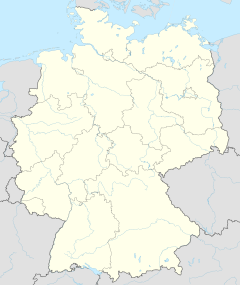
Riesling is a white grape variety that originated in the Rhine region. Riesling is an aromatic grape variety displaying flowery, almost perfumed, aromas as well as high acidity. It is used to make dry, semi-sweet, sweet, and sparkling white wines. Riesling wines are usually varietally pure and are seldom oaked. As of 2004, Riesling was estimated to be the world's 20th most grown variety at 48,700 hectares, but in terms of importance for quality wines, it is usually included in the "top three" white wine varieties together with Chardonnay and Sauvignon blanc. Riesling is a variety that is highly "terroir-expressive", meaning that the character of Riesling wines is greatly influenced by the wine's place of origin.
Oenology is the science and study of wine and winemaking. Oenology is distinct from viticulture, which is the science of the growing, cultivation, and harvesting of grapes. The English word oenology derives from the Greek word oinos "wine" and the suffix –logia the "study of". An oenologist is an expert in the science of wine and of the arts and techniques for making wine.
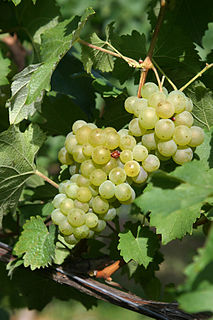
Bacchus is a white wine grape created by viticulturalist Peter Morio at the Geilweilerhof Institute for Grape Breeding in the Palatinate in 1933. He crossed a Silvaner x Riesling cross with Müller-Thurgau.

Müller-Thurgau is a white grape variety which was created by Hermann Müller from the Swiss Canton of Thurgau in 1882 at the Geisenheim Grape Breeding Institute in Germany. It is a crossing of Riesling with Madeleine Royale. It is used to make white wine in Germany, Austria, Northern Italy, Hungary, England, Australia, the Czech Republic, Slovakia, Slovenia, New Zealand, Canada, the United States, Belgium and Japan. There are around 22,201 hectares ) cultivated worldwide, which makes Müller-Thurgau the most widely planted of the so-called "new breeds" of grape varieties created since the late 19th century. Although plantings have decreased significantly since the 1980s, as of 2019 it was still Germany's second most planted variety at 11,400 hectares and 11.4% of the total vineyard surface. In 2007, the 125th anniversary was celebrated at the Geisenheim Grape Breeding Institute. Müller-Thurgau is also known as Rivaner, Riesling x Sylvaner, Riesling-Sylvaner, Rizvanec (Slovenia) and Rizlingszilváni (Hungary).

Hermann Müller, was a Swiss botanist, plant physiologist, oenologist and grape breeder. He called himself Müller-Thurgau, taking the name of his home canton.
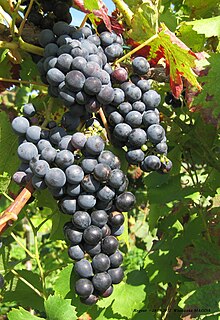
Regent is a dark-skinned inter-specific hybrid grape variety, used for making wine. It has both European and American vine species in its pedigree and a broad resistance against the most significant fungal diseases which affect grapes, such as downy mildew.

Rondo is a dark-skinned grape variety, used for making red wine. It is a hybrid grape or inter-specific crossing. It was created in 1964 by Professor Vilém Kraus in then-Czechoslovakia by crossing the varieties Zarya Severa and St. Laurent. He offered it to Dr. Helmut Becker (1927-1990) of the Geisenheim Grape Breeding Institute who conducted further work on it, which explains why the grape is known under a Geisenheim designation. The variety was first planted for research and later in bigger scale in the mid 1980s by Thomas Walk Vineyard in Ireland under the name Amurensis Walk; it was named Rondo in 1997.

Helmut Becker, German viticulturist, was chief of the Geisenheim Grape Breeding Institute. As a successor of Heinrich Birk, he viewed viticulture from a global perspective and promoted the globalization of a quality wine industry. Dr. Becker collaborated with numerous scientists around the world and encouraged the importation of important clones and varieties in New Zealand, Canada, Australia, Japan and other countries. He did early important work in Neustadt/Weinstrasse during the 1950s and 1960s in the European phylloxera eradication program.
Breidecker is white variety of grape. It is a hybrid grape, an interspecific crossing × Seibel 7053. It can be used to make a German style light white wine with apple and pear flavors. "This cultivar was released by the Geisenheim Research Station, Germany, in 1962. Has the technical name GM 4894. It was derived from a Müller-Thurgau cross with the Chancellor hybrid cultivar and can currently be found in limited areas in the South Island of New Zealand, where it is mainly used for producing somewhat neutral varietal and blend white wines. Resistant to bunch rot and downy mildew fungus diseases. Breidecker was named after Heinrich Breidecker, one of New Zealand pioneer grape growers."
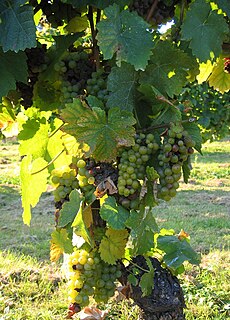
Morio Muscat is a white wine grape that was created by viticulturalist Peter Morio at the Geilweilerhof Institute for Grape Breeding in the Palatinate in 1928. He claimed to have crossed the varieties Silvaner and Pinot blanc, but based on the variety's properties it has been speculated that he actually crossed Silvaner and Muscat Blanc à Petits Grains. But so far this speculation has yet to be conclusively proven. The grape is highly aromatic with a "grapey" characteristic reminiscent of Muscat grape varieties. The grape is rarely used for varietal wines because it requires a high level of ripeness to avoid producing wine with a "mousey" flavor, a coarse texture and overabundance of acidity.
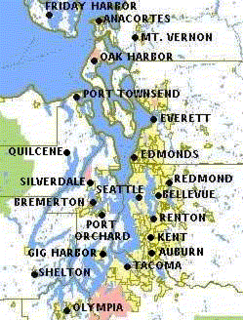
The Puget Sound AVA is an American Viticultural Area in western Washington State. It is the only AVA in the state of Washington that is located west of the Cascade Mountains. Note that in 2019 there is a committee working to establish a southwestern WA AVA.

Rheinhessen is the largest of 13 German wine regions (Weinanbaugebiete) for quality wines with 26,758 hectares under cultivation in 2018. Named for the traditional region of Rhenish Hesse, it lies on the left bank of the Rhine between Worms and Bingen in the federal state of Rhineland-Palatinate. Despite its historic name it is currently no longer part of the federal-state of Hesse, this being the case since the end of World War II. There have been several unsuccessful attempts to legally reunite the former wine growing districts of Mainz on the Hessian side during the post-war area. Rheinhessen produces mostly white wine from a variety of grapes, particularly Riesling, Müller-Thurgau and Silvaner, and is best known as the home of Liebfraumilch, although some previously underrated Rieslings are also made, increasingly in a powerful dry style.

The Kerner grape is an aromatic white grape variety. It was bred in 1929 by August Herold by crossing Trollinger and Riesling. Herold was working at a plant breeding station in Lauffen in the Württemberg region of Germany. This station belonged to a state breeding institute headquartered in Weinsberg. It received varietal protection and was released for general cultivation in 1969.

Madeleine Royale is a variety of white grape. It is mostly grown for table grapes or ornamental purposes, but is notable as a parent of Müller-Thurgau and Madeleine Angevine. It ripens extremely early, in some cases by the 22 July, the feast day of Mary Magdalene - hence the name.

Solaris is a variety of grape used for white wine. It was created in 1975 at the grape breeding institute in Freiburg, Germany by Norbert Becker.
Optima is a white wine grape that was created by viticulturalist Peter Morio at the Geilweilerhof Institute for Grape Breeding in the Palatinate in 1930. Morio crossed a Riesling x Silvaner cross with Müller-Thurgau. The Riesling x Silvaner is sometimes mentioned as Rieslaner, but more often just as "a Riesling x Silvaner". Due to the random element of genetic recombination involved in sexual reproduction of plants, no two crosses of the same parent grape varieties will be identical, so there is a difference between the Riesling x Silvaner cross Rieslaner, and each other such cross.
Gutenborner is a white German wine grape that is also used in English wine production. The grape was created in 1928 by Heinrich Birk at Forschungsanstalt Geisenheim by crossing of Müller-Thurgau and Bicane.
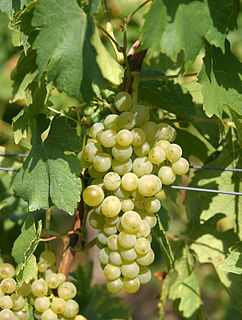
Arnsburger is a white variety of grape used for wine. It was created 1939 by Heinrich Birk (1898-1973) at the Geisenheim Grape Breeding Institute by crossing two clones of Riesling, clone 88 and clone 64. Arnsburger did not receive varietal protection until 1984. It was named after Arnsburg Abbey, a ruin of a Cistercian abbey in Wetterau, as a homage of the importance of Cistercians in the history of German wine.

Heinrich Birk was a German viticulturist. He was head of the Geisenheim Grape Breeding Institute. Heinrich Birk studied philosophy at the University of Giessen after his initial graduation 1920–1923 in agronomy at the university of Bonn and after 1924 in addition to an initial position on the domain Steinberg, Kloster Eberbach. He received his doctorate in this subject in 1929. At this time he was already two years as clerk at the Geisenheim Research Center at the Institute of vines finishing as an assistant to Professor F. Muth. 1939 he became head of the Reichs-Rebenzuchtstation. He had to quit a year later because of his compulsory military service. 1945 Birk returned and devoted himself in postwar reconstruction.

The Geisenheim Yeast Breeding Center was founded in 1894 and is located in the town of Geisenheim, in Germany's Rheingau.

